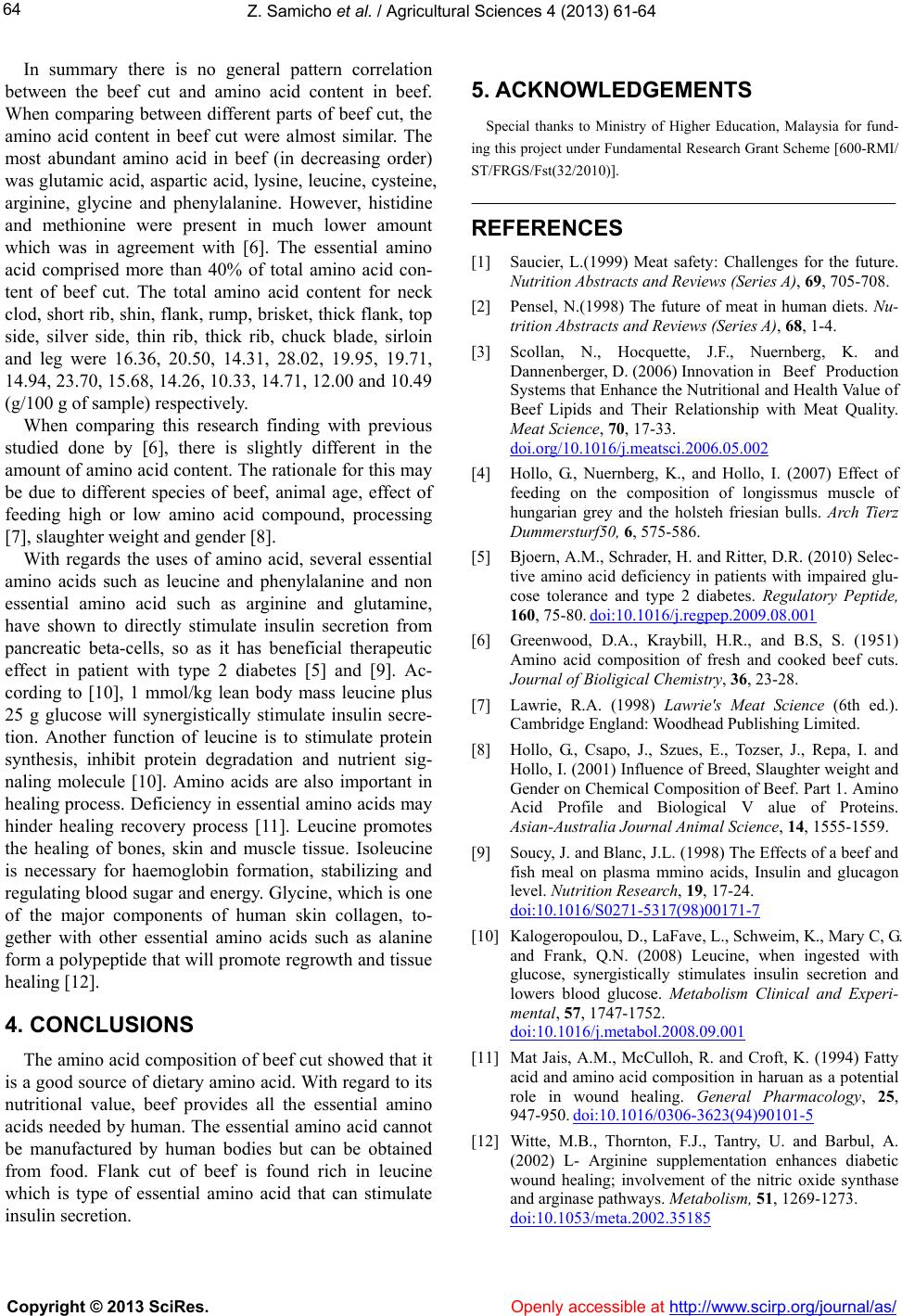
Z. Samicho et al. / Agricultural Sciences 4 (2013) 61-64
64
Copyright © 2013 SciRes. Openly accessible at http://www.scirp.org/journal/as/
In summary there is no general pattern correlation
between the beef cut and amino acid content in beef.
When comparing between different parts of beef cut, the
amino acid content in beef cut were almost similar. The
most abundant amino acid in beef (in decreasing order)
was glutamic acid, aspartic acid, lysine, leucine, cysteine,
arginine, glycine and phenylalanine. However, histidine
and methionine were present in much lower amount
which was in agreement with [6]. The essential amino
acid comprised more than 40% of total amino acid con-
tent of beef cut. The total amino acid content for neck
clod, short rib, shin, flank, rump, brisket, thick flank, top
side, silver side, thin rib, thick rib, chuck blade, sirloin
and leg were 16.36, 20.50, 14.31, 28.02, 19.95, 19.71,
14.94, 23.70, 15.68, 14.26, 10.33, 14.71, 12.00 and 10.49
(g/100 g of sample) respectively.
When comparing this research finding with previous
studied done by [6], there is slightly different in the
amount of amino acid content. The rationale for this may
be due to different species of beef, animal age, effect of
feeding high or low amino acid compound, processing
[7], slaughter weight and gender [8].
With regards the uses of amino acid, several essential
amino acids such as leucine and phenylalanine and non
essential amino acid such as arginine and glutamine,
have shown to directly stimulate insulin secretion from
pancreatic beta-cells, so as it has beneficial therapeutic
effect in patient with type 2 diabetes [5] and [9]. Ac-
cording to [10], 1 mmol/kg lean body mass leucine plus
25 g glucose will synergistically stimulate insulin secre-
tion. Another function of leucine is to stimulate protein
synthesis, inhibit protein degradation and nutrient sig-
naling molecule [10]. Amino acids are also important in
healing process. Deficiency in essential amino acids may
hinder healing recovery process [11]. Leucine promotes
the healing of bones, skin and muscle tissue. Isoleucine
is necessary for haemoglobin formation, stabilizing and
regulating blood sugar and energy. Glycine, which is one
of the major components of human skin collagen, to-
gether with other essential amino acids such as alanine
form a polypeptide that will promote regrowth and tissue
healing [12].
4. CONCLUSIONS
The amino acid composition of beef cut showed that it
is a good source of dietary amino acid. With regard to its
nutritional value, beef provides all the essential amino
acids needed by human. The essential amino acid cannot
be manufactured by human bodies but can be obtained
from food. Flank cut of beef is found rich in leucine
which is type of essential amino acid that can stimulate
insulin secretion.
5. ACKNOWLEDGEMENTS
Special thanks to Ministry of Higher Education, Malaysia for fund-
ing this project under Fundamental Research Grant Scheme [600-RMI/
ST/FRGS/Fst(32/2010)].
REFERENCES
[1] Saucier, L.(1999) Meat safety: Challenges for the future.
Nutrition Abstracts and Reviews (Series A), 69, 705-708.
[2] Pensel, N.(1998) The future of meat in human diets. Nu-
trition Abstracts and Reviews (Series A), 68, 1-4.
[3] Scollan, N., Hocquette, J.F., Nuernberg, K. and
Dannenberger, D. (2006) Innovation in Beef Production
Systems that Enhance the Nutritional and Health Value of
Beef Lipids and Their Relationship with Meat Quality.
Meat Scie nce, 70, 17-33.
doi.org/10.1016/j.meatsci.2006.05.002
[4] Hollo, G., Nuernberg, K., and Hollo, I. (2007) Effect of
feeding on the composition of longissmus muscle of
hungarian grey and the holsteh friesian bulls. Arch Tierz
Dummersturf50, 6, 575-586.
[5] Bjoern, A.M., Schrader, H. and Ritter, D.R. (2010) Selec-
tive amino acid deficiency in patients with impaired glu-
cose tolerance and type 2 diabetes. Regulatory Peptide,
160, 75-80. doi:10.1016/j.regpep.2009.08.001
[6] Greenwood, D.A., Kraybill, H.R., and B.S, S. (1951)
Amino acid composition of fresh and cooked beef cuts.
Journal of Bioligical Chemistry, 36, 23-28.
[7] Lawrie, R.A. (1998) Lawrie's Meat Science (6th ed.).
Cambridge England: Woodhead Publishing Limited.
[8] Hollo, G., Csapo, J., Szues, E., Tozser, J., Repa, I. and
Hollo, I. (2001) Influence of Breed, Slaughter weight and
Gender on Chemical Composition of Beef. Part 1. Amino
Acid Profile and Biological V alue of Proteins.
Asian-Australia Journal Animal Science, 14, 1555-1559.
[9] Soucy, J. and Blanc, J.L. (1998) The Effects of a beef and
fish meal on plasma mmino acids, Insulin and glucagon
level. Nutr ition Rese arch, 19, 17-24.
doi:10.1016/S0271-5317(98)00171-7
[10] Kalogeropoulou, D., LaFave, L., Schweim, K., Mary C, G.
and Frank, Q.N. (2008) Leucine, when ingested with
glucose, synergistically stimulates insulin secretion and
lowers blood glucose. Metabolism Clinical and Experi-
mental, 57, 1747-1752.
doi:10.1016/j.metabol.2008.09.001
[11] Mat Jais, A.M., McCulloh, R. and Croft, K. (1994) Fatty
acid and amino acid composition in haruan as a potential
role in wound healing. General Pharmacology, 25,
947-950. doi:10.1016/0306-3623(94)90101-5
[12] Witte, M.B., Thornton, F.J., Tantry, U. and Barbul, A.
(2002) L- Arginine supplementation enhances diabetic
wound healing; involvement of the nitric oxide synthase
and arginase pathways. Metabolism, 51, 1269-1273.
doi:10.1053/meta.2002.35185